Sukarafernandes
On this page, you find all documents, package deals, and flashcards offered by seller sukarafernandes.
- 17
- 0
- 0
Community
- Followers
- Following
17 items
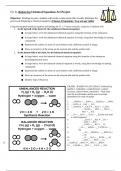
Chemical Equations
A Chemical Equations Art Project involves creatively representing chemical equations through visual art. Participants use artistic techniques to illustrate the components and transformations in chemical reactions, such as reactants, products, and the processes involved. This project helps in understanding and visualizing chemical concepts by combining art with science, making abstract ideas more accessible and engaging. It can also serve as an educational tool to reinforce learning and spark int...
- Presentation
- • 3 pages •
A Chemical Equations Art Project involves creatively representing chemical equations through visual art. Participants use artistic techniques to illustrate the components and transformations in chemical reactions, such as reactants, products, and the processes involved. This project helps in understanding and visualizing chemical concepts by combining art with science, making abstract ideas more accessible and engaging. It can also serve as an educational tool to reinforce learning and spark int...

Chemical Reaction Notes
Chemical reactions involve the transformation of substances into new products through the breaking and forming of chemical bonds. Reactants are the starting materials that undergo a chemical change, resulting in products with different properties. These reactions are characterized by changes such as color shifts, gas production, or temperature changes. Chemical reactions are fundamental to various processes, from biological functions to industrial applications, and are governed by principles suc...
- Class notes
- • 2 pages •
Chemical reactions involve the transformation of substances into new products through the breaking and forming of chemical bonds. Reactants are the starting materials that undergo a chemical change, resulting in products with different properties. These reactions are characterized by changes such as color shifts, gas production, or temperature changes. Chemical reactions are fundamental to various processes, from biological functions to industrial applications, and are governed by principles suc...
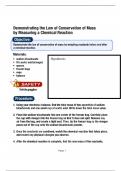
conversion Mass Lab
In a Law of Conservation of Mass lab, the principle being tested is that mass is neither created nor destroyed in a chemical reaction. During the lab, students typically perform a chemical reaction in a closed system and measure the mass of the reactants before the reaction and the mass of the products after the reaction. The expectation is that the total mass remains constant throughout the process, demonstrating that mass is conserved. This experiment helps illustrate the foundational concept ...
- Presentation
- • 2 pages •
In a Law of Conservation of Mass lab, the principle being tested is that mass is neither created nor destroyed in a chemical reaction. During the lab, students typically perform a chemical reaction in a closed system and measure the mass of the reactants before the reaction and the mass of the products after the reaction. The expectation is that the total mass remains constant throughout the process, demonstrating that mass is conserved. This experiment helps illustrate the foundational concept ...
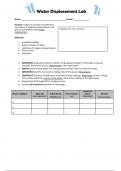
Water Displacement Lab
Water displacement is a method used to measure the volume of an object by observing the amount of water it displaces when submerged. By recording the initial water level in a container and then noting the new water level after the object is added, the difference in levels indicates the object's volume. This technique is commonly used in experiments and practical applications, such as determining the volume of irregularly shaped objects or objects that do not have straightforward geometric dimen...
- Presentation
- • 3 pages •
Water displacement is a method used to measure the volume of an object by observing the amount of water it displaces when submerged. By recording the initial water level in a container and then noting the new water level after the object is added, the difference in levels indicates the object's volume. This technique is commonly used in experiments and practical applications, such as determining the volume of irregularly shaped objects or objects that do not have straightforward geometric dimen...

Flame Test Lab
A Bunsen burner lab involves using a Bunsen burner, a common piece of laboratory equipment, to conduct experiments that require controlled heating. The Bunsen burner produces a flame that can be adjusted to different temperatures by controlling the gas flow and air supply. In such labs, students or researchers typically use the burner to heat substances, sterilize equipment, or carry out various chemical reactions. Proper use and safety precautions are essential to prevent accidents and ensure a...
- Presentation
- • 3 pages •
A Bunsen burner lab involves using a Bunsen burner, a common piece of laboratory equipment, to conduct experiments that require controlled heating. The Bunsen burner produces a flame that can be adjusted to different temperatures by controlling the gas flow and air supply. In such labs, students or researchers typically use the burner to heat substances, sterilize equipment, or carry out various chemical reactions. Proper use and safety precautions are essential to prevent accidents and ensure a...
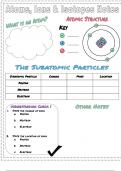
Atoms vs. Ions
Atoms are the basic building blocks of matter, consisting of a nucleus (made of protons and neutrons) and a cloud of electrons orbiting around it. Ions are atoms that have gained or lost one or more electrons, resulting in a net electrical charge. Positive ions (cations) are formed when atoms lose electrons, while negative ions (anions) are formed when atoms gain electrons.
- Class notes
- • 5 pages •
Atoms are the basic building blocks of matter, consisting of a nucleus (made of protons and neutrons) and a cloud of electrons orbiting around it. Ions are atoms that have gained or lost one or more electrons, resulting in a net electrical charge. Positive ions (cations) are formed when atoms lose electrons, while negative ions (anions) are formed when atoms gain electrons.
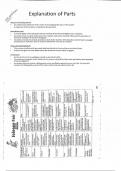
Enzymes Recrucence
Enzymes are specialized proteins that act as biological catalysts, speeding up chemical reactions in living organisms without being consumed in the process. They work by lowering the activation energy required for reactions to occur, thus increasing the rate of biochemical processes essential for life. Enzymes are highly specific, meaning each enzyme typically catalyzes only one type of reaction or acts on a specific substrate. They are crucial for various functions, including digestion, metabol...
- Class notes
- • 1 pages •
Enzymes are specialized proteins that act as biological catalysts, speeding up chemical reactions in living organisms without being consumed in the process. They work by lowering the activation energy required for reactions to occur, thus increasing the rate of biochemical processes essential for life. Enzymes are highly specific, meaning each enzyme typically catalyzes only one type of reaction or acts on a specific substrate. They are crucial for various functions, including digestion, metabol...
